TVT Sling and Abdominal Pain
Complete TVT sling removal is a form of transvaginal mesh removal and can be performed using both laparoscopy and a vaginal approach in patients who suffer from vaginal, pubic and or lower abdominal pain. TVT sling also known as tension free vaginal tape sling is the original retropubic synthetic sling for stress urine incontinence that was introduced in Europe in 1995 and finally into the United States in 1998. The TVT sling works by elevating or creating a support system for the urethra which limits the descent of the urethra with coughing, sneezing and increases in intraabdominal pressure. This mechanism of action stops cough leakage 90% of the time. Dr Miklos learned the TVT retropubic procedure in Uppsala Sweden and was one of the first surgeons in the country to teach and do the surgery here in the United States. The retropubic TVT sling was considered a technological advancement over previous sling procedures as it was considered simple, quick, less invasive, a less painful surgery with smaller incisions and initially thought to have less intraoperative and immediate postoperative complications compared to its predecessors.
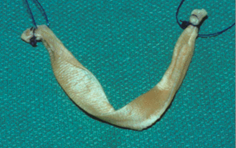 Traditional Type Slings |
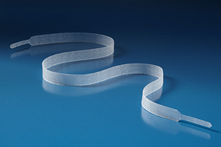 TVT Sling – Synthetic |
Over the years Drs Miklos & Moore learned by listening to their patients that the TVT retropubic sling can cause many different types of complications or problems including: mesh extrusion or mesh exposure through the vagina skin, mesh erosion into the bladder or urethra, vaginal pain, painful intercourse and lower abdominal or pubic pain. Dr Miklos had initially thought it was impossible for a patient to develop pain from the sling unless there was an extrusion through the skin or an erosion into the bladder but over the last 20 years he has learned that this is not the case. There is little doubt in Drs Miklos & Moore’s minds that the TVT sling can indeed cause lower abdominal, pubic, upper leg and vaginal pain. Now this does not happen with every patient but if a patient complains of these problems her complaints should be taken seriously and her TVT sling should be suspect.
Drs Miklos and Moore have heard the stories from hundreds of patients who have been told it is impossible to remove all the mesh or it impossible to remove the sling. It has also been Drs Miklos & Moore experience when a surgeon states they can remove the whole or complete sling they are referring just to the vaginal portion of the sling. Very few surgeons will remove the whole sling. The whole sling can be removed almost completely in greater than 95% of patients. The reality of the situation is most surgeons have not been trained nor do they have the skills to perform complete TVT sling removals. If they do have the skill to remove the sling they do the sling removal through a large abdominal incision instead of the minimally invasive laparoscopic approach. Drs Miklos & Moore have removed hundreds of TVT retropubic slings through a vaginal and laparoscopic approach. This means the patient will have one small incision in the vagina and usually 4 small incision on the abdomen.
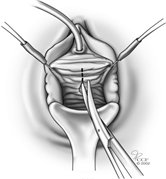 Vaginal incision |
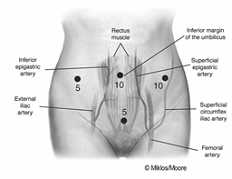 Laparoscopic incisions |
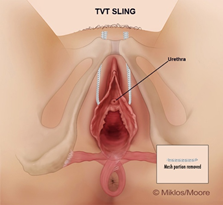 TVT Removal |
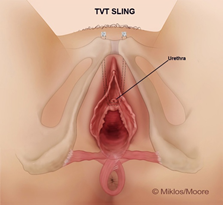 TVT Removal |
The reason why some patients suffer from lower abdominal pain after a retropubic TVT sling is the mesh creates a chronic inflammatory reaction and this creates scar tissue which surrounds in around the holes known as pores. The more scar tissue which forms the greater the pulling or shortening of the mesh sling and this then pulls on the myofascial (muscle and fascial) layer of both the abdomen and the vagina. The tighter the sling gets the more tension there is on the nerves of the lower abdominal and vaginal wall. This is not unlike naturally forming adhesion of the abdominal cavity which can also cause pain. Here we have mesh which is the biggest and strongest adhesion the human body has ever seen. If the patient suffers from lower abdominal pain Dr Miklos & Moore would recommend removing as much of the sling as possible or the whole sling thus reducing the pulling on the abdominal wall and its associated pain. Please read their study on indications or reasons for mesh and sling removal by clicking here
Of course, as with any surgery there are the potential of risks which include: bladder injury (1%), inability to find and remove the mesh (1 %), bowel injury (< 1/1000), urethra injury (< 1%), bleeding and subsequent blood transfusion (<1%), failure for the pain to go away (<10%), and the return of stress urinary incontinence (>95%). The above percentages are the risks associated with surgery and in the hands of Drs Miklos & Moore and not in the hands of surgeons with less experience. Very few people in the world can claim to remove all the TVT retropubic mesh by a laparoscopic approach with such a low complication rate. Please see two of the world’s largest papers written by Drs Miklos & Moore’s on complications associated with synthetic sling removal. Read by clicking the articles below.
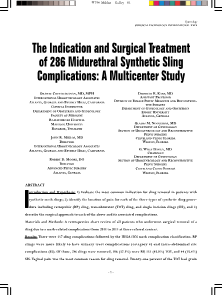 Reason for Synthetic Slings Removal |
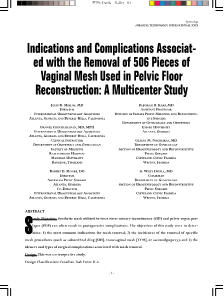 Complications with Mesh Removal |
These studies are the largest known scientific study in the world on removing TVT type slings and it are written by Dr Miklos & Moore. Please see www.miklosandmoore.com for more information.

